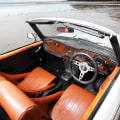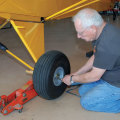When it comes to maintaining your Triumph TR, troubleshooting chassis issues can be a tricky and time-consuming process. From squeaky brakes to a misaligned suspension, diagnosing and addressing these issues can be a daunting task. But with the right knowledge and tools, you can troubleshoot chassis problems quickly and easily. In this article, we'll discuss the basics of chassis maintenance and provide tips and techniques for troubleshooting your Triumph TR.
Troubleshooting Chassis Issues
can be a daunting task for car owners, especially those with limited mechanical knowledge.Fortunately, many of the most common problems can be addressed with a few simple steps. The first step in troubleshooting chassis issues is to inspect the entire chassis for any signs of damage or wear. Look for signs of rust or corrosion, as well as any loose or broken parts. Pay particular attention to areas that are prone to damage such as suspension and steering components.
If any problems are identified, they should be addressed immediately to prevent further damage or deterioration. Once the chassis has been inspected, it is important to identify the specific problem. This can often be done by testing the components individually, such as running the steering system to see if it is functioning correctly. If a component is found to be faulty, it may need to be replaced or repaired.
It is also important to check for any worn or damaged parts, and replace them as needed. Repairing the chassis can often involve replacing worn or damaged parts, or using specialized tools and techniques. In some cases, it may be necessary to remove components and replace them with new ones. If this is the case, it is important to use the correct components and follow the manufacturer's instructions carefully.
In addition to repairs, regular maintenance can help to keep the chassis in good condition. This includes checking for leaks, inspecting all moving parts for wear, and cleaning all surfaces regularly. Regular maintenance can help prevent future problems from developing and ensure that the chassis continues to perform at its peak level. For more serious issues, it may be necessary to seek professional help.
Professional mechanics have specialized tools and techniques that can identify and address complex problems quickly and efficiently. They can also provide advice on how to maintain the chassis in the best condition possible. In conclusion, troubleshooting chassis issues can be a challenging but rewarding task. By inspecting the chassis regularly and performing routine maintenance tasks, car owners can easily identify and address common issues before they become more serious problems.
Finally, seeking professional help when necessary can help ensure that your vehicle runs safely and reliably for years to come.
Chassis Maintenance Tips
Maintaining your Triumph TR chassis is key to keeping it in top condition. To keep your chassis in good condition, you should regularly clean and lubricate parts, as well as take steps to prevent rust and corrosion. When cleaning parts of the chassis, use a soft, non-abrasive cloth with a mild detergent or soap. Be sure to use gentle motions when wiping down parts, as harsh scrubbing can cause damage.After cleaning, be sure to dry the parts completely to prevent rust and corrosion. You should also regularly lubricate the moving parts of the chassis, such as the suspension, steering components, and brakes. This will help ensure that they move properly and last longer. Use a high-quality lubricant that is suitable for the application, such as grease or oil.
To prevent rust and corrosion, you should wax the chassis regularly. This will help protect the metal from moisture and other environmental elements that can cause damage. Be sure to use a wax that is designed specifically for automotive use. By following these tips, you can keep your Triumph TR chassis in excellent condition for many years to come.
Inspecting the Chassis
It is important to regularly inspect the chassis of your Triumph TR to ensure that it is in top condition. This inspection can help identify potential issues before they become major problems.While inspecting the chassis, look out for any signs of rust, cracks, or loose parts. It is also important to safely access the underside of the vehicle for a more detailed inspection. To inspect the chassis, start by visually examining the entire frame. Check for any signs of rust, corrosion, or dents in the metal. Look out for any cracks or damage that may have occurred due to wear and tear or an accident.
Also check that all the components are securely attached. Pay particular attention to the suspension and shock absorbers, as these parts are most prone to wear and tear. When inspecting the underside of the vehicle, use a jack and lift it up so that you can safely access the area. Carefully examine the exhaust system, brakes, suspension components, and other parts for any signs of damage. If any of these parts are loose or damaged, it is best to replace them as soon as possible. It is also important to check for any leaks, such as those from the engine or transmission.
These can often be identified by looking for pools of liquid near these components. If you notice any leaks, it is best to take your vehicle to a qualified mechanic for further inspection and repairs. Inspecting the chassis of your Triumph TR is an important part of regular maintenance. By regularly inspecting your chassis, you can identify potential issues before they become major problems. It is also important to safely access the underside of the vehicle for a more detailed inspection.
Repairing Chassis Issues
When it comes to repairing chassis issues on a Triumph TR, it can be difficult to know when to call a professional mechanic and when it is safe to make repairs yourself.In general, it is recommended that you consult a professional if the problem is complicated or if the repair requires specialized tools. However, for more minor repairs, you may be able to make the repairs yourself with the right tools and supplies. When attempting to repair a chassis issue, it is important to have the right tools and supplies on hand. A few essential items for making repairs include wrenches, pliers, screwdrivers, tape measure, hammer, grinding wheel, and a jack. It is also important to make sure you have the correct replacement parts for any components that need to be replaced.
In addition to having the proper tools and supplies, it is important to understand how the Triumph TR's chassis works and how it can be repaired. To do this, you should familiarize yourself with the chassis diagrams in the Triumph TR's manual. Additionally, there are several online resources that provide detailed explanations and diagrams of the Triumph TR's chassis. Once you have a better understanding of the chassis and the required tools and supplies, you can begin making repairs. If possible, start by addressing minor issues like loose bolts or missing screws.
If more serious issues are present, such as broken suspension components, then you may need to replace these components with new ones. In some cases, it may be necessary to remove parts of the chassis in order to make repairs. If this is the case, then you should use caution when removing and replacing parts. Additionally, if you are replacing any suspension components, it is important to ensure that they are properly aligned in order for them to work correctly. Making repairs on your Triumph TR's chassis can be a difficult task. However, with the right tools and supplies and a good understanding of how the chassis works, it is possible to make minor repairs yourself.
If major issues arise or if you are unsure of how to proceed, it is best to consult a professional mechanic. Regularly inspecting and maintaining your Triumph TR's chassis is essential for keeping it in top condition. By following the tips in this article, you can identify potential issues early and make repairs as needed. If you ever have any questions or need professional help, be sure to contact a qualified mechanic to ensure your Triumph TR remains in optimal condition.


